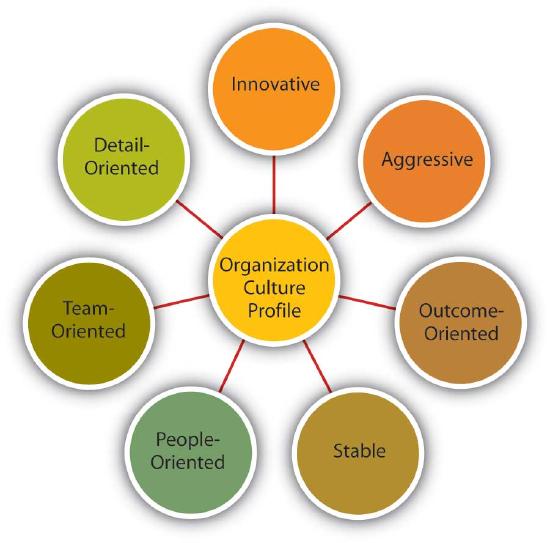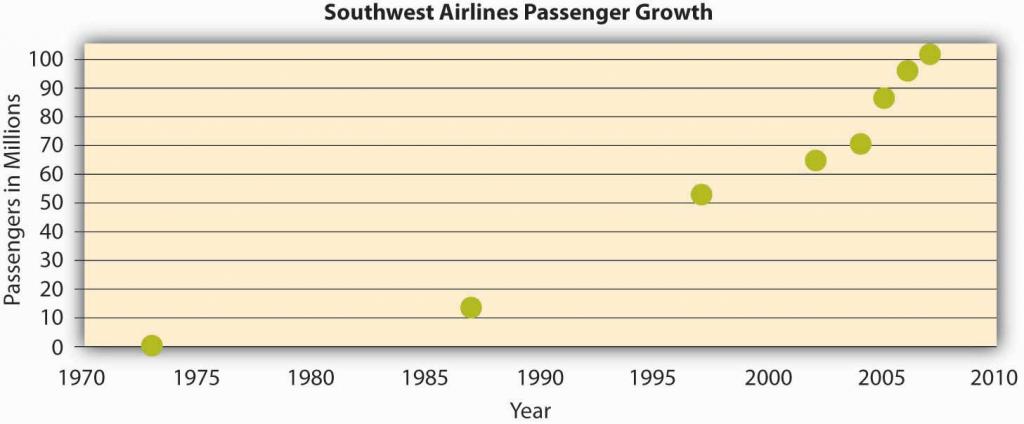15.3: Characteristics of Organizational Culture
- Page ID
- 4729
Learning Objectives
- Understand different dimensions of organizational culture.
- Understand the role of culture strength.
- Explore subcultures within organizations.
Dimensions of Culture
Which values characterize an organization’s culture? Even though culture may not be immediately observable, identifying a set of values that might be used to describe an organization’s culture helps us identify, measure, and manage culture more effectively. For this purpose, several researchers have proposed various culture typologies. One typology that has received a lot of research attention is the organizational culture profile (OCP), in which culture is represented by seven distinct values (Chatman & Jehn, 1991; O’Reilly, Chatman, & Caldwell, 1991). We will describe the OCP as well as two additional dimensions of organizational culture that are not represented in that framework but are important dimensions to consider: service culture and safety culture.

Innovative Cultures
According to the OCP framework, companies that have innovative cultures are flexible and adaptable, and experiment with new ideas. These companies are characterized by a flat hierarchy in which titles and other status distinctions tend to be downplayed. For example, W. L. Gore & Associates Inc. is a company with innovative products such as GORE-TEX® (the breathable fabric that is windproof and waterproof), Glide dental floss, and Elixir guitar strings, earning the company the distinction of being elected as the most innovative company in the United States by Fast Company magazine in 2004. W. L. Gore consistently manages to innovate and capture the majority of market share in a wide variety of industries, in large part due to its unique culture. In this company, employees do not have bosses in the traditional sense, and risk taking is encouraged by celebrating failures as well as successes (Deutschman, 2004). Companies such as W. L. Gore, Genentech Inc., and Google also encourage their employees to take risks by allowing engineers to devote 20% of their time to projects of their own choosing (Deutschman, 2004; Morris, Burke, & Neering, 2006).
Aggressive Cultures

Companies with aggressive cultures value competitiveness and outperforming competitors: By emphasizing this, they may fall short in the area of corporate social responsibility. For example, Microsoft Corporation is often identified as a company with an aggressive culture. The company has faced a number of antitrust lawsuits and disputes with competitors over the years. In aggressive companies, people may use language such as “We will kill our competition.” In the past, Microsoft executives often made statements such as “We are going to cut off Netscape’s air supply.…Everything they are selling, we are going to give away.” Its aggressive culture is cited as a reason for getting into new legal troubles before old ones are resolved (Greene, Reinhardt, & Lowry, 2004; Schlender, 1998). Recently, Microsoft founder Bill Gates established the Bill & Melinda Gates foundation and is planning to devote his time to reducing poverty around the world (Schlender, 2007). It will be interesting to see whether he will bring the same competitive approach to the world of philanthropy.
Outcome-Oriented Cultures
The OCP framework describes outcome-oriented cultures as those that emphasize achievement, results, and action as important values. A good example of an outcome-oriented culture may be Best Buy Co. Inc. Having a culture emphasizing sales performance, Best Buy tallies revenues and other relevant figures daily by department. Employees are trained and mentored to sell company products effectively, and they learn how much money their department made every day (Copeland, 2004). In 2005, the company implemented a results oriented work environment (ROWE) program that allows employees to work anywhere and anytime; they are evaluated based on results and fulfillment of clearly outlined objectives (Thompson, 2005). Outcome-oriented cultures hold employees as well as managers accountable for success and utilize systems that reward employee and group output. In these companies, it is more common to see rewards tied to performance indicators as opposed to seniority or loyalty. Research indicates that organizations that have a performance-oriented culture tend to outperform companies that are lacking such a culture (Nohria, Joyce, & Roberson, 2003). At the same time, some outcome-oriented companies may have such a high drive for outcomes and measurable performance objectives that they may suffer negative consequences. Companies overrewarding employee performance such as Enron Corporation and WorldCom experienced well-publicized business and ethical failures. When performance pressures lead to a culture where unethical behaviors become the norm, individuals see their peers as rivals and short-term results are rewarded; the resulting unhealthy work environment serves as a liability (Probst & Raisch, 2005).
Stable Cultures
Stable cultures are predictable, rule-oriented, and bureaucratic. These organizations aim to coordinate and align individual effort for greatest levels of efficiency. When the environment is stable and certain, these cultures may help the organization be effective by providing stable and constant levels of output (Westrum, 2004). These cultures prevent quick action, and as a result may be a misfit to a changing and dynamic environment. Public sector institutions may be viewed as stable cultures. In the private sector, Kraft Foods Inc. is an example of a company with centralized decision making and rule orientation that suffered as a result of the culture-environment mismatch (Thompson, 2006).Its bureaucratic culture is blamed for killing good ideas in early stages and preventing the company from innovating. When the company started a change program to increase the agility of its culture, one of their first actions was to fight bureaucracy with more bureaucracy: They created the new position of VP of business process simplification, which was later eliminated (Boyle, 2004; Thompson, 2005; Thompson, 2006).
People-Oriented Cultures
People-oriented cultures value fairness, supportiveness, and respect for individual rights. These organizations truly live the mantra that “people are their greatest asset.” In addition to having fair procedures and management styles, these companies create an atmosphere where work is fun and employees do not feel required to choose between work and other aspects of their lives. In these organizations, there is a greater emphasis on and expectation of treating people with respect and dignity (Erdogan, Liden, & Kraimer, 2006). One study of new employees in accounting companies found that employees, on average, stayed 14 months longer in companies with people-oriented cultures (Sheridan, 1992). Starbucks Corporation is an example of a people-oriented culture. The company pays employees above minimum wage, offers health care and tuition reimbursement benefits to its part-time as well as full-time employees, and has creative perks such as weekly free coffee for all associates. As a result of these policies, the company benefits from a turnover rate lower than the industry average (Weber, 2005; Motivation secrets, 2003). The company is routinely ranked as one of the best places to work by Fortune magazine.
Team-Oriented Cultures
Companies with team-oriented cultures are collaborative and emphasize cooperation among employees. For example, Southwest Airlines Company facilitates a team-oriented culture by cross-training its employees so that they are capable of helping each other when needed. The company also places emphasis on training intact work teams (Bolino & Turnley, 2003). Employees participate in twice daily meetings named “morning overview meetings” (MOM) and daily afternoon discussions (DAD) where they collaborate to understand sources of problems and determine future courses of action. In Southwest’s selection system, applicants who are not viewed as team players are not hired as employees (Miles & Mangold, 2005).In team-oriented organizations, members tend to have more positive relationships with their coworkers and particularly with their managers (Erdogan, Liden, & Kraimer, 2006).
Detail-Oriented Cultures
Organizations with detail-oriented cultures are characterized in the OCP framework as emphasizing precision and paying attention to details. Such a culture gives a competitive advantage to companies in the hospitality industry by helping them differentiate themselves from others. For example, Four Seasons Hotels Ltd. and the Ritz-Carlton Company LLC are among hotels who keep records of all customer requests, such as which newspaper the guest prefers or what type of pillow the customer uses. This information is put into a computer system and used to provide better service to returning customers. Any requests hotel employees receive, as well as overhear, might be entered into the database to serve customers better. Recent guests to Four Seasons Paris who were celebrating their 21st anniversary were greeted with a bouquet of 21 roses on their bed. Such clear attention to detail is an effective way of impressing customers and ensuring repeat visits. McDonald’s Corporation is another company that specifies in detail how employees should perform their jobs by including photos of exactly how French fries and hamburgers should look when prepared properly (Fitch, 2004; Ford & Heaton, 2001; Kolesnikov-Jessop, 2005; Markels, 2007).
Service Culture
Service culture is not one of the dimensions of OCP, but given the importance of the retail industry in the overall economy, having a service culture can make or break an organization. Some of the organizations we have illustrated in this section, such as Nordstrom, Southwest Airlines, Ritz-Carlton, and Four Seasons are also famous for their service culture. In these organizations, employees are trained to serve the customer well, and cross-training is the norm. Employees are empowered to resolve customer problems in ways they see fit. Because employees with direct customer contact are in the best position to resolve any issues, employee empowerment is truly valued in these companies. For example, Umpqua Bank, operating in the northwestern United States, is known for its service culture. All employees are trained in all tasks to enable any employee to help customers when needed. Branch employees may come up with unique ways in which they serve customers better, such as opening their lobby for community events or keeping bowls full of water for customers’ pets. The branches feature coffee for customers, Internet kiosks, and withdrawn funds are given on a tray along with a piece of chocolate. They also reward employee service performance through bonuses and incentives (Conley, 2005; Kuehner-Herbert, 2003).
What differentiates companies with service culture from those without such a culture may be the desire to solve customer-related problems proactively. In other words, in these cultures employees are engaged in their jobs and personally invested in improving customer experience such that they identify issues and come up with solutions without necessarily being told what to do. For example, a British Airways baggage handler noticed that first-class passengers were waiting a long time for their baggage, whereas stand-by passengers often received their luggage first. Noticing this tendency, a baggage handler notified his superiors about this problem, along with the suggestion to load first-class passenger luggage last Ford & Heaton, 2001). This solution was successful in cutting down the wait time by half. Such proactive behavior on the part of employees who share company values is likely to emerge frequently in companies with a service culture.



